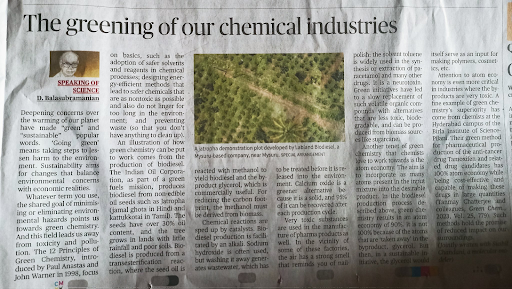Description
Copyright infringement not intended
Source: Twitter
Context
Growing concern about global warming has made the terms "green" and "sustainable" popular. 'Going green' refers to taking steps to reduce environmental harm, such as implementing eco-friendly practices. Sustainability seeks to balance environmental concerns with economic realities.
What is Green Chemistry?
Green chemistry is the process of creating chemical products and methods that reduce or eliminate the emission of harmful pollutants.
Key features:
- Waste prevention: Preventing the production of garbage is always preferable to cleaning up waste that has already been created.
- Atom economy: Green chemistry-based synthetic processes and technologies must constantly strive to maximize raw material consumption and incorporation into the final product. To reduce waste generated by any process, this must be strictly followed.
- Preventing the production of hazardous chemicals: Reactions and processes that involve the synthesis of certain toxic substances that are harmful to human health must be improved to avoid their production.
- Designing safe chemicals: When developing chemical products that serve a specific purpose, special care must be taken to ensure that the chemical is as non-toxic to humans and the environment as possible.
- Designing safe auxiliaries and solvents: Auxiliaries should be avoided in processes to the greatest extent possible. Even in situations where they are absolutely necessary, they must be designed to be as safe as possible.
- Energy efficiency: The process should consume as little energy as possible.
- Renewable feedstock and raw materials must be prioritized over non-renewable feedstock and materials.
- Derivatives should only be used when absolutely necessary, as they frequently require the use of additional reagents and chemicals, resulting in waste generation.
- The use of chemical catalysts and catalytic reagents should be encouraged in order to reduce the energy requirements of the chemical reactions in the process.
- Designing chemicals for degradation: When developing a chemical product for a specific application, special care must be taken to ensure that the chemical does not pollute the environment. This can be accomplished by ensuring that the chemical breaks down into non-toxic compounds.
- Real-time analysis should be implemented: procedures and analytical methodologies should be improved so that they can provide real-time data for monitoring purposes. This enables the parties involved to stop or regulate the process before any harmful or dangerous compounds are produced.
- Incorporating safe chemistry to prevent accidents: When designing chemical processes, it is critical to ensure that the compounds used are safe to use. This can help prevent workplace disasters such as explosions and fires. Furthermore, this can help to create a safer environment for the process to take place in.
Source: The Hindu
|
Practice Question:
Q. Which of the following statements best describes the concept of "Green Chemistry" in the context of greening chemical industries?
It refers to the use of only organic compounds in industrial production.
It aims to reduce or eliminate the use and generation of hazardous substances in the design, manufacture, and application of chemical products.
It is a concept that promotes faster production of chemicals using synthetic catalysts.
It involves replacing fossil fuels with nuclear energy in chemical plants.
Select the correct answer using the code below:
A) 1 only
B) 2 only
C) 1 and 3 only
D) 2 and 4 only
Answer:
B) 2 only
Explanation:
Statement 1 is incorrect: Green chemistry is not limited to organic compounds; it focuses on sustainable processes.
Statement 2 is correct: This is the definition of green chemistry as per the US EPA and widely accepted scientific standards.
Statement 3 is incorrect: Green chemistry is not primarily about speed but about safety and sustainability.
Statement 4 is incorrect: Replacing energy sources is part of broader sustainability but not specific to green chemistry principles.
|









